Elevated Garden Box Wicking Planter:
How to Build a Self-Watering Raised Bed SIP on Legs!
This all new, elevated grow box is a large, self-watering, raised SIP or sub-irrigated planter. The growing system fits perfectly into any urban garden. My original version was my most complicated endeavor in the world of wicking SIPs. As one of my very first projects, the design and construction process was over-engineered. It served its purpose as a permanent structure, performing well throughout its FOURTEEN years of use. However, since working with that prototype, I've addressed a couple design flaws, while greatly streamlining the entire fabrication process.
USAGE: This self-watering garden system is perfect for elderly, handicapped or disabled people who have difficulty bending over. It is partially pest resistant since it is raised off of the ground. In particular though, since this is an SIP, it is a water-wise, drought resistant planter. The sub-irrigated water reservoir stores rain water and minimizes water run-off. It makes watering so easy!
Some perennial herbs can be grown in SIP grow boxes. But keep a few things in mind. In colder regions, the potting mix is likely to freeze solid. Chives will survive this. Other herbs may not. Also, your entire box will eventually become root bound. Newer plantings will likely be choked out by older, more established perennials. This page talks even more about what you can expect from your SIP garden bed.
I recommend a rotation of Spring / Summer / Fall annual vegetables. Lettuce, arugula, spinach, mustard, etc. are good candidates. I've found that growing lettuce in a raised self-watering garden box like this has be a dream come true for me. The planter is high enough to keep rabbits out. And the lettuce is totally drought proof!
Building a Sturdy Elevated Garden Bed, Built to Last!
My mid-sized elevated raised bed is very heavy when filled up with soil and water. It requires 15 cubic feet of potting mix to fill it up. And the water reservoir holds about 20 gallons of water, which is 160 pounds just to fill the reservoir! I've seen some poorly designed self-watering planters on legs which did not have enough reinforcement on the bottom. Subsequently, growers began complaining that the bottom was falling out!
 Understandably, this customer was upset to see the bottom fallen out of this $240 planter kit!
Understandably, this customer was upset to see the bottom fallen out of this $240 planter kit!
With a well designed planter, you shouldn't need think twice. My elevated planters are constructed with stainless steel bolts and/or lag screws driven through pressure treated lumber. The legs are sturdy 4x4 posts. And the cross supports are treated 2x4 boards. This will enable the planter to hold up well for at least a couple decades!
How to Design an Elevated SIP Planter on Legs:
 This improved elevated SIP garden box is a heavy duty, raised, wicking planter.
This improved elevated SIP garden box is a heavy duty, raised, wicking planter.
CAPACITY:
Root Zone: 15 cubic feet of potting mix.
Reservoir: 20 gallons of water.
 This wicking planter holds a vast amount of water, while maintaining good root aeration.
This wicking planter holds a vast amount of water, while maintaining good root aeration.
Directions: How to Build a Wicking Box on Legs
Unfortunately, the original project was too complex for me to itemize each and every step. However I'll soon be releasing a full tutorial for my all new, revised version!
Original Prototype SIP Wicking Box Construction:
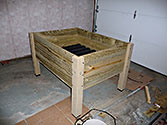
Albo-grow Box - Setting up my raised SIP wicking box in the garage.
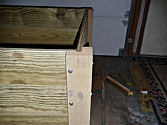
I used notched, treated 4x4 lumber for the legs.
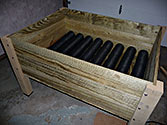
SIP Grow Box - The sides were made of treated 1x6 boards.
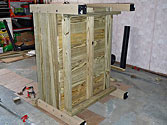
Albo-grow Box - I used plastic caps at the base of the legs to reduce ground contact and prevent premature rotting.
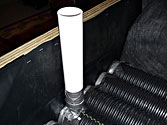
Sub-irrigated Planter - The down spout (fill tube) was made from some PVC tubing.
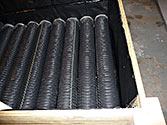
Albo-grow Box Reservoir - The drain pipes were capped off with synthetic fabric to keep out dirt. Note how closely they are placed together.
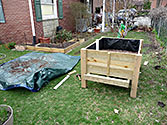
SIP Raised Wicking Bed - You can blend your custom potting mix on a tarp. Then begin filling your SIP box.
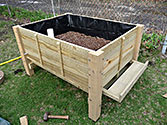
Albo-grow Box - Try to use the best fasteners you can get. For treated, you need high grade stainless bolts. Any decking screws need to be coated to resist corrosion.
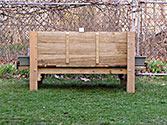
The Mighty Albo-grow Box - The ultimate in drought proof, self-watering gardening!
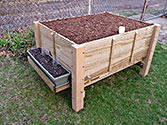
Extending the SIP Box - I added ledges allowing me to attach window box planters on the sides.
2011 Urban Gardening Growing Season:

Albo-grow Box (2011) - Season extending is a great urban gardening tool. I draped 6 mil plastic over the mini greenhouse to protect against late frost.
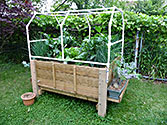
Raised Wicking Garden Box (2011) - The peppers were already beginning to shade the lettuce plants.
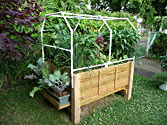
Organic Urban Gardening 2011 - Kale was grown in the window boxes.
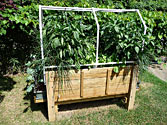
Water-wise High Density Garden 2011 - The peppers were lush and massive!
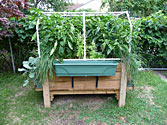
Albo-grow Box - The extra window box enhanced the look of the SIP planter.
2012 Urban Gardening Growing Season:
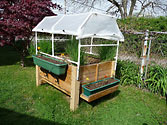
Wicking Planter (2012) - The chives survived the Winter with no issues and it was time to plant some marigolds.
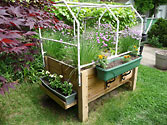
Albo-grow Box - Beautiful perennial chive flowers and some annual flowers too.
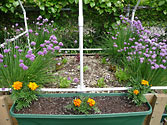
Albo-grow Box (2012) - The young lettuce seedlings had to fight the chive roots which were already established.
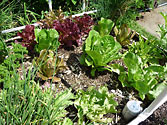
Self-watering Garden (2012) - These lettuce were being crushed by the brutal Summer sun. The water reservoir kept them going, but it was more sun than they needed.
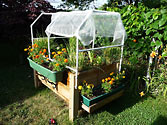
SIP Lettuce - I used some insect netting as a shade cloth to provide some relief.
2013 Urban Gardening Growing Season (New Location):

Wicking Planter (2013) - In the early Spring, the chives awake after another freezing Winter.
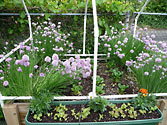
Elevated Garden Planter - Lots of lovely flowers on the chives along with plenty of green leaf veggies.
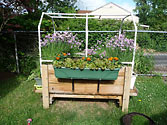
Elevated Garden Box (2013) - The window box had been a nice compliment to the wicking planter.
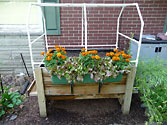
After buying my property, I decided to move the SIP to the side of the house.
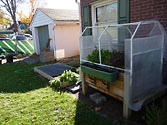
SIP Elevated Bed - I still had time in the Fall to grown some arugula and mustard greens.
2014 Urban Gardening Growing Season:
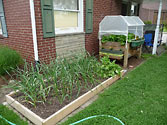
Wicking Planter (2014) - In the early Spring, my mini-greenhouse covering protected crops from late frosts.
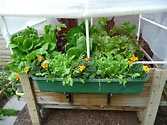
SIP Elevated Bed - I had removed the perennial chives, making room for lettuce greens.
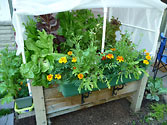
Self-watering Garden Box (2014) - The greenhouse covering also shaded the lettuce from intense mid-day sunlight.
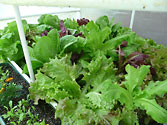
Self-watering Garden - The lettuce plants were lush and the leaves stayed nice and crisp.
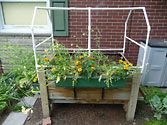
Elevated Garden Bed - As the arugula bolts and goes to seed, the Spring growing season comes to an end.
2015 Urban Gardening Growing Season:

Wicking Planter (2013) - The chives survived the Winter with no issues and it was time to plant some marigolds.

Albo-grow Box - Beautiful perennial chive flowers and some annual flowers too.

Albo-grow Box (2012) - The young lettuce seedlings had to fight the chive roots which were already established.

Self-watering Garden (2012) - These lettuce were being crushed by the brutal Summer sun. The water reservoir kept them going, but it was more sun than they needed.

SIP Lettuce - I used some insect netting as a shade cloth to provide some relief.
2016 Urban Gardening Growing Season:

Albo-grow Box - Beautiful perennial chive flowers and some annual flowers too.

Albo-grow Box (2012) - The young lettuce seedlings had to fight the chive roots which were already established.

Self-watering Garden (2012) - These lettuce were being crushed by the brutal Summer sun. The water reservoir kept them going, but it was more sun than they needed.

Wicking Planter (2013) - The chives survived the Winter with no issues and it was time to plant some marigolds.

SIP Lettuce - I used some insect netting as a shade cloth to provide some relief.
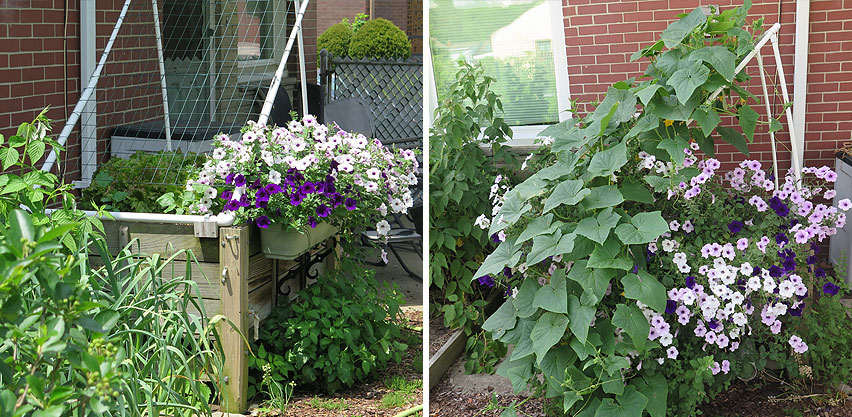 Even after 14 years, my original elevated SIP garden bed was still super productive!
Even after 14 years, my original elevated SIP garden bed was still super productive!
HOW TO (Make an SIP Raised Bed) →













































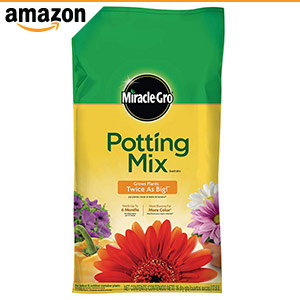
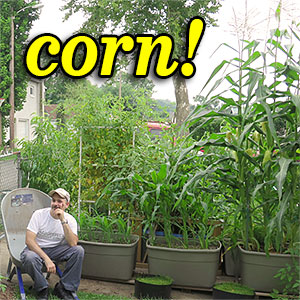
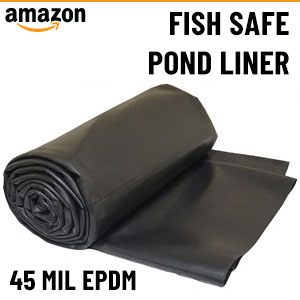
![GARDENERS: Who else would pay money for poop? [Gardening T-Shirt Design]](images/GARDENERS--Who-else-would-pay-money-for-poop_Gardening-Tshirt-th.jpg)
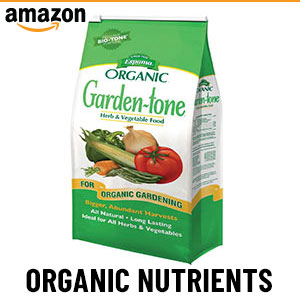
![Long Live PERENNIALS! [Gardening T-Shirt Design] Long Live PERENNIALS! [Gardening T-Shirt Design]](images/Long-Live-PERENNIALS-Gardening-T-Shirt-th.jpg)